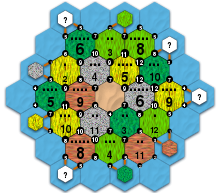Centered hexagonal number

19 land tiles,
37 total tiles
In mathematics and combinatorics, a centered hexagonal number, or centered hexagon number,[1][2] is a centered figurate number that represents a hexagon with a dot in the center and all other dots surrounding the center dot in a hexagonal lattice. The following figures illustrate this arrangement for the first four centered hexagonal numbers:
Centered hexagonal numbers should not be confused with cornered hexagonal numbers, which are figurate numbers in which the associated hexagons share a vertex.
The sequence of hexagonal numbers starts out as follows (sequence A003215 in the OEIS):
Formula
[edit]
The nth centered hexagonal number is given by the formula[2]
Expressing the formula as
shows that the centered hexagonal number for n is 1 more than 6 times the (n − 1)th triangular number.
In the opposite direction, the index n corresponding to the centered hexagonal number can be calculated using the formula
This can be used as a test for whether a number H is centered hexagonal: it will be if and only if the above expression is an integer.
Recurrence and generating function
[edit]The centered hexagonal numbers satisfy the recurrence relation[2]
From this we can calculate the generating function . The generating function satisfies
The latter term is the Taylor series of , so we get
and end up at
Properties
[edit]
In base 10 one can notice that the hexagonal numbers' rightmost (least significant) digits follow the pattern 1–7–9–7–1 (repeating with period 5). This follows from the last digit of the triangle numbers (sequence A008954 in the OEIS) which repeat 0-1-3-1-0 when taken modulo 5. In base 6 the rightmost digit is always 1: 16, 116, 316, 1016, 1416, 2316, 3316, 4416... This follows from the fact that every centered hexagonal number modulo 6 (=106) equals 1.
The sum of the first n centered hexagonal numbers is n3. That is, centered hexagonal pyramidal numbers and cubes are the same numbers, but they represent different shapes. Viewed from the opposite perspective, centered hexagonal numbers are differences of two consecutive cubes, so that the centered hexagonal numbers are the gnomon of the cubes. (This can be seen geometrically from the diagram.) In particular, prime centered hexagonal numbers are cuban primes.
The difference between (2n)2 and the nth centered hexagonal number is a number of the form 3n2 + 3n − 1, while the difference between (2n − 1)2 and the nth centered hexagonal number is a pronic number.
Applications
[edit]
Many segmented mirror reflecting telescopes have primary mirrors comprising a centered hexagonal number of segments (neglecting the central segment removed to allow passage of light) to simplify the control system.[3] Some examples:
| Telescope | Number of segments |
Number missing |
Total | n-th centered hexagonal number |
|---|---|---|---|---|
| Giant Magellan Telescope | 7 | 0 | 7 | 2 |
| James Webb Space Telescope | 18 | 1 | 19 | 3 |
| Gran Telescopio Canarias | 36 | 1 | 37 | 4 |
| Guido Horn d'Arturo's prototype | 61 | 0 | 61 | 5 |
| Southern African Large Telescope | 91 | 0 | 91 | 6 |
References
[edit]- ^ Hindin, H. J. (1983). "Stars, hexes, triangular numbers and Pythagorean triples". J. Rec. Math. 16: 191–193.
- ^ a b c Deza, Elena; Deza, M. (2012). Figurate Numbers. World Scientific. pp. 47–55. ISBN 978-981-4355-48-3.
- ^ Mast, T. S. and Nelson, J. E. Figure control for a segmented telescope mirror. United States: N. p., 1979. Web. doi:10.2172/6194407.
See also
[edit]Lua error in Module:Navbox at line 192: attempt to concatenate field 'argHash' (a nil value).











